
Eyeglass prescription
Encyclopedia

If an examination indicates that corrective lenses are appropriate, the prescriber generally provides the patient with an eyewear prescription at the conclusion of the exam. In fact, in the United States, the FTC (Federal Trade Commission
Federal Trade Commission
The Federal Trade Commission is an independent agency of the United States government, established in 1914 by the Federal Trade Commission Act...
) requires eyewear prescribers to give each patient a copy of their prescription, immediately following the concluding exam, even if the patient doesn't ask for a copy.
The parameters specified on spectacle prescriptions vary, but typically include the power to which each lens should be made in order to correct blurred vision
Visual perception
Visual perception is the ability to interpret information and surroundings from the effects of visible light reaching the eye. The resulting perception is also known as eyesight, sight, or vision...
due to refractive errors, including myopia
Myopia
Myopia , "shortsightedness" ) is a refractive defect of the eye in which collimated light produces image focus in front of the retina under conditions of accommodation. In simpler terms, myopia is a condition of the eye where the light that comes in does not directly focus on the retina but in...
, hyperopia
Hyperopia
Hyperopia, also known as farsightedness, longsightedness or hypermetropia, is a defect of vision caused by an imperfection in the eye , causing difficulty focusing on near objects, and in extreme cases causing a sufferer to be unable to focus on objects at any distance...
, astigmatism
Astigmatism (eye)
Astigmatism is an optical defect in which vision is blurred due to the inability of the optics of the eye to focus a point object into a sharp focused image on the retina. This may be due to an irregular or toric curvature of the cornea or lens. There are two types of astigmatism: regular and...
, and presbyopia
Presbyopia
Presbyopia is a condition where the eye exhibits a progressively diminished ability to focus on near objects with age. Presbyopia’s exact mechanisms are not known with certainty; the research evidence most strongly supports a loss of elasticity of the crystalline lens, although changes in the...
. It is typically determined using a phoropter
Phoropter
A phoropter is an instrument commonly used by eye care professionals during an eye examination, containing different lenses used for refraction of the eye during sight testing, to measure an individual's refractive error and determine his or her eyeglass prescription.Typically, the patient sits...
asking the patient which lens is best, computer automated refractor, and through the technique of retinoscopy. Opticians are not eye doctors and, therefore, are not licensed to write an eyeglass prescription. A dispensing optician will take a prescription written by an optometrist or ophthalmologist and order and/or assemble the frames and lenses to then be dispensed and sold to the patient.
Abbreviations and terms
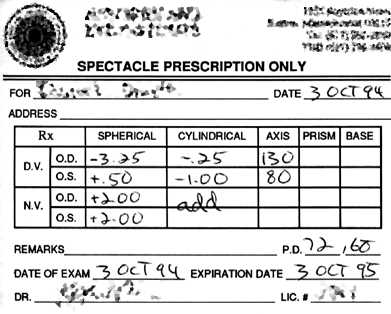
Similar to medical prescription
Medical prescription
A prescription is a health-care program implemented by a physician or other medical practitioner in the form of instructions that govern the plan of care for an individual patient. Prescriptions may include orders to be performed by a patient, caretaker, nurse, pharmacist or other therapist....
s, eyeglass prescriptions are written on paper pads that frequently contain a number of different abbreviations and terms:
- DV is an abbreviation for distance vision. This specifies the part of the prescription designed primarily to improve far vision. In a bifocal lens, this generally indicates what is to be placed in the top segment.
- NV is an abbreviation for near vision. This may represent a single-vision lens prescription to improve near work, or the reading portion of a bifocal lens. Some prescription forms use ADD in place of NV with a single box to indicate the additional refractive power to be added to the spherical of each eye.
- OD is an abbreviation for oculus dexter, LatinLatinLatin is an Italic language originally spoken in Latium and Ancient Rome. It, along with most European languages, is a descendant of the ancient Proto-Indo-European language. Although it is considered a dead language, a number of scholars and members of the Christian clergy speak it fluently, and...
for right eye. Oculus means eye. In some countries, such as the United KingdomUnited KingdomThe United Kingdom of Great Britain and Northern IrelandIn the United Kingdom and Dependencies, other languages have been officially recognised as legitimate autochthonous languages under the European Charter for Regional or Minority Languages...
RE (right eye), LE (left eye), and BE (both eyes) are used. Sometimes, just right and left are used. - OS is an abbreviation for oculus sinister, Latin for left eye.
- OU is an abbreviation for oculi uterque, Latin for both eyes.
- A spherical correction corrects refractive error of the eye with a single convergent or divergent refractive power in all meridians.
- A cylindrical correction corrects astigmatic refractive errorAstigmatism (eye)Astigmatism is an optical defect in which vision is blurred due to the inability of the optics of the eye to focus a point object into a sharp focused image on the retina. This may be due to an irregular or toric curvature of the cornea or lens. There are two types of astigmatism: regular and...
of the eye by adding or subtracting power cylindrically in a meridian specified by the prescribed axis. - The axis indicates the angle in degrees of one of two major meridians the prescribed cylindrical power is in. Which major meridian is referenced is indicated by the cylindrical correction being in plus or minus notation. The axis is measured on an imaginary semicircle with a horizontal baseline that starts with zero degrees in the 3 o'clock (or east) direction, and increases to 180 degrees in a counter-clockwise direction.
Most eyeglass prescriptions will contain values here. The spherical and cylindrical columns contain lens powers in diopters
Dioptre
A dioptre, or diopter, is a unit of measurement of the optical power of a lens or curved mirror, which is equal to the reciprocal of the focal length measured in metres . It is thus a unit of reciprocal length. For example, a 3-dioptre lens brings parallel rays of light to focus at metre...
(see below).
- Prism and Base are usually left empty, as they are not seen in most prescriptions. Prism refers to a displacement of the image through the lens, and is used to treat eye muscle imbalances or other conditions (see vergence dysfunction) that cause errors in eye orientation or fixation. Prism correction is measured in "prism diopters", and Base refers to the direction of displacement.
- Pupillary Distance (PD) is the distance between pupils, usually given in millimeters, it is sometimes known as the interpupillary Distance (IPD). It is written as two values if the prescription is for bifocals or progressive lenses - these are the pupillary distances for the distance and near fixation (essentially, the upper and lower part of the lenses). They differ due to pupillary convergenceConvergence (eye)In ophthalmology, convergence is the simultaneous inward movement of both eyes toward each other, usually in an effort to maintain single binocular vision when viewing an object. This action is mediated by the medial rectus muscle, which is innervated by Cranial nerve III...
when looking at near objects. Additionally, an eyeglasses prescription may include a monocular pupillary distance ("monocular PD"). These measurements indicate, in millimeters, the distances from each pupil to the center of the nose where the center of the frame bridge rests. PD measurements are essential for all spectacle dispensings, monocular PDs being essential in progressive lenses and for those with high prescription. PDs can be measured using a pupilometerPupilometerPupilometer is the name used for two different devices—one that measures the distance between pupils, and one that measures the pupil's response to visual stimuli.- Pupillary distance measurement :...
or by using a ruler. In countries such as the United KingdomUnited KingdomThe United Kingdom of Great Britain and Northern IrelandIn the United Kingdom and Dependencies, other languages have been officially recognised as legitimate autochthonous languages under the European Charter for Regional or Minority Languages...
, PD measurement is not a legal requirement as part of the prescription and is often not included. - Back vertex distance (BVD ) is the distance between the back of the spectacle lens and the front of the corneaCorneaThe cornea is the transparent front part of the eye that covers the iris, pupil, and anterior chamber. Together with the lens, the cornea refracts light, with the cornea accounting for approximately two-thirds of the eye's total optical power. In humans, the refractive power of the cornea is...
(the front surface of the eye). This is essential in higher prescriptions (usually above ±4.00D) as slight changes in the distance between the spectacles and the eyes above this level can cause the patient to perceive a different power, leading to blur and/or other symptoms.
Background
Blur is the subjective experience or perception of a defocus aberrationDefocus aberration
In optics, defocus is the aberration in which an image is simply out of focus. This aberration is familiar to anyone who has used a camera, videocamera, microscope, telescope, or binoculars. Optically, defocus refers to a translation along the optical axis away from the plane or surface of best...
within the eye
Human eye
The human eye is an organ which reacts to light for several purposes. As a conscious sense organ, the eye allows vision. Rod and cone cells in the retina allow conscious light perception and vision including color differentiation and the perception of depth...
. Blur may appear differently depending on the amount and type of refractive error. The following are some examples of blurred images that may result from refractive errors:
Blur is corrected by focusing light on the retina. This may be done with eyeglasses or contact lenses, or by altering the shape of various eye structures via refractive surgery
Refractive surgery
Refractive eye surgery is any eye surgery used to improve the refractive state of the eye and decrease or eliminate dependency on glasses or contact lenses. This can include various methods of surgical remodeling of the cornea or cataract surgery. The most common methods today use excimer lasers to...
or special contact lenses.
Eyeglasses sometimes have unwanted effects including magnification or reduction, distortion, color fringes, altered depth perception, etc. Although many people think of lenses as magnifiers, the lenses within eyeglasses improve vision primarily by reducing blur. Depending on the optical setup, they may also produce magnification or reduction of images which may or may not be intentional or desirable. Oftentimes, magnifiers are part of a regimen prescribed by low vision optometrists to help people with reduced vision.
The visual acuity is measured with an eye chart
Eye chart
An eye chart is a chart used to measure visual acuity. Types of eye charts include the logMAR chart, Snellen chart, Landolt C, and the Lea test.-Procedure:Charts usually display several rows of optotypes , each row in a different size...
. The eye chart is the background used by eye doctors to compare the patient's visual acuity
Visual acuity
Visual acuity is acuteness or clearness of vision, which is dependent on the sharpness of the retinal focus within the eye and the sensitivity of the interpretative faculty of the brain....
with the one of other human beings. Although there are many variations of the eye chart, the standard one is the Snellen eye chart, which was developed by Dutch eye doctor Hermann Snellen
Hermann Snellen
Herman Snellen was a Dutch ophthalmologist who introduced the Snellen chart to study visual acuity . He took over directorship of the Netherlands Hospital for Eye Patients after Dr...
in the 1860s. Usually, these charts show 11 rows of capital letters and it is common that the first row contains one letter (the "big E") and the other rows contain letters that are progressively smaller. Other types of chart eyes are the Landolt C
Landolt C
A Landolt C, also known as a Japanese Vision Test, Landolt ring or Landolt broken ring, is an optotype, i.e. a standardized symbol used for testing vision. It was developed by the Swiss-born ophthalmologist Edmund Landolt....
, Lea test
Lea test
A Lea test is a visual acuity test tailored for children who do not know the alphabet normally used in eye charts. The optotypes are outlines of an apple, a house, a square, and a circle. This test was developed by Finnish ophthalmologist Lea Hyvärinen in 1976 and has been calibrated against...
or Tibetan eye chart
Tibetan eye chart
The Tibetan eye chart is a tool allegedly developed by Tibetan monks. According to some authors, it can be used to train the muscles and nerves of the optical system, correcting visual problems. However, the International Orthoptic Association has found no scientific evidence of the effectiveness ...
.
Individuals who are not able to read letters for various reasons including being too young to know the alphabet
Alphabet
An alphabet is a standard set of letters—basic written symbols or graphemes—each of which represents a phoneme in a spoken language, either as it exists now or as it was in the past. There are other systems, such as logographies, in which each character represents a word, morpheme, or semantic...
or having a handicap, eye doctors may use what is called the tumbling E chart. This type of chart is a variation of the Snellen chart and it shows the capital letter E, at different sizes and rotated in increments of 90 degrees. The scale of the tumbling E chart is the same as with the standard Snellen chart. The eye doctor, in this case, will ask the person being tested to use either hand
Hand
A hand is a prehensile, multi-fingered extremity located at the end of an arm or forelimb of primates such as humans, chimpanzees, monkeys, and lemurs...
(with their fingers extended) to show which direction the "fingers" of the E are pointing: right, left, up or down.
In the United States
United States
The United States of America is a federal constitutional republic comprising fifty states and a federal district...
, a 20/20 visual acuity is considered normal. This means that the chart is normally placed at 20 feet distance from the person who is being tested. 20/20 visual acuity is considered normal vision for individuals but not perfect as some individuals, although rarely, can see at 20 feet what others can see at 10. The poorest visual acuity is 20/200 and a person with the best-corrected vision, or vision once wearing corrected lenses, of 20/200 is normally considered legally blind
Blindness
Blindness is the condition of lacking visual perception due to physiological or neurological factors.Various scales have been developed to describe the extent of vision loss and define blindness...
. Individuals with 20/200 vision are normally able to read only the first letter on the chart. Usually the 20/20 line of letters is fourth from the bottom, with 20/15, 20/10 and 20/5 below that. Not many people have 20/10 or better visual acuity, but many animals do, especially birds of prey, which have been estimated to have an acuity of 20/5 or even better. In the United States individuals who want to get their driver license without a corrective lenses restriction must have at least 20/40 visual acuity.
Eye charts do not provide information on the peripheral vision
Peripheral vision
Peripheral vision is a part of vision that occurs outside the very center of gaze. There is a broad set of non-central points in the field of view that is included in the notion of peripheral vision...
, depth perception
Depth perception
Depth perception is the visual ability to perceive the world in three dimensions and the distance of an object. Depth sensation is the ability to move accurately, or to respond consistently, based on the distances of objects in an environment....
or color perception and therefore they are not sufficient in establishing an accurate prescription. This is the main reason why a complete eye exam will include more tests. However, eye charts are useful in deciding whether the patients need eyeglasses or contact lenses to correct their distance vision.
Lens power
The values indicated in the sphere and cylinder columns of an eyeglass prescription specify the optical powerOptical power
Optical power is the degree to which a lens, mirror, or other optical system converges or diverges light. It is equal to the reciprocal of the focal length of the device. The dioptre is the most common unit of measurement of optical power...
of the lenses in diopters, abbreviated D. The higher the number of diopters, the more the lens refracts or bends light. A diopter is the reciprocal of the focal length
Focal length
The focal length of an optical system is a measure of how strongly the system converges or diverges light. For an optical system in air, it is the distance over which initially collimated rays are brought to a focus...
in meters. If a lens has a focal length of meters, it is a 3 diopter lens.
A +10 diopter lens, which has a focal length of 10 centimeters, would make a good magnifying glass. Eyeglass lenses are usually much weaker, because eyeglasses do not work by magnifying; they work by correcting focus. A typical human eye without refractive error has a refractive power of approximately 60 diopters.
Stacking lenses combines their power linearly. A +1 diopter lens combined with a +2 diopter lens forms a +3 diopter system.

Lenses come in positive (plus) and negative (minus) powers. Given that a positive power lens will magnify an object and a negative power lens will minify it, it is often possible to tell whether a lens is positive or negative by looking through it.
Positive lenses cause light rays to converge and negative lenses cause light rays to diverge. A negative lens combined with a positive lens results in a system with a power equal to the sum of the two lenses, so a −2 lens combined with a +5 lens forms a +3 diopter system.
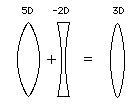
A −3 lens stacked on top of a +3 lens looks almost like flat glass, because the combined power is 0.

In science textbooks, positive lenses are usually diagrammed as convex on both sides; negative lenses are usually diagrammed as concave on both sides. In a real optical system, the best optical quality is usually achieved where most rays of light are roughly normal (i.e., at a right angle) to the lens surface. In the case of an eyeglass lens, this means that the lens should be roughly shaped like a cup with the hollow side toward the eye, so most eyeglass lenses are menisci in shape.
The most important characteristic of a lens is its principal focal length
Focal length
The focal length of an optical system is a measure of how strongly the system converges or diverges light. For an optical system in air, it is the distance over which initially collimated rays are brought to a focus...
, or its inverse which is called the lens strength or lens power. The principal focal length of a lens is determined by the index of refraction of the glass, the radii of curvature of the surfaces, and the medium in which the lens resides. For a thin double convex lens, all parallel rays will be focused to a point referred to as the principal focal point. The distance
Distance
Distance is a numerical description of how far apart objects are. In physics or everyday discussion, distance may refer to a physical length, or an estimation based on other criteria . In mathematics, a distance function or metric is a generalization of the concept of physical distance...
from the lens to that point is the principal focal length of the lens. For a double concave lens where the rays are diverged, the principal focal length is the distance at which the back-projected rays would come together and it is given a negative sign. For a thick lens made from spherical surfaces, the focal distance will differ for different rays, and this change is called spherical aberration
Spherical aberration
thumb|right|Spherical aberration. A perfect lens focuses all incoming rays to a point on the [[Optical axis|optic axis]]. A real lens with spherical surfaces suffers from spherical aberration: it focuses rays more tightly if they enter it far from the optic axis than if they enter closer to the...
. The focal length for different wavelengths will also differ slightly, and this is called chromatic aberration
Chromatic aberration
In optics, chromatic aberration is a type of distortion in which there is a failure of a lens to focus all colors to the same convergence point. It occurs because lenses have a different refractive index for different wavelengths of light...
.
Spherical lenses and spherical correction
Usually:- the spherical component is the main correction
- the cylindrical component is "fine tuning".
Depending on the optical setup, lenses can act as magnifiers, lenses can introduce blur, and lenses can correct blur.
Whatever the setup, spherical lenses act equally in all meridians: they magnify, introduce blur, or correct blur the same amount in every direction.
An ordinary magnifying glass is a kind of spherical lens. In a simple spherical lens, each surface is a portion of a sphere. When a spherical lens acts as a magnifier, it magnifies equally in all meridians. Here, note that the magnified letters are magnified both in height and in width.

Similarly, when a spherical lens puts an optical system out of focus and introduces blur, it blurs equally in all meridians:
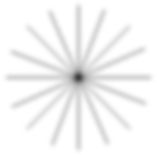
Here is how this kind of blur looks when viewing an eye chart. This kind of blur involves no astigmatism
Astigmatism (eye)
Astigmatism is an optical defect in which vision is blurred due to the inability of the optics of the eye to focus a point object into a sharp focused image on the retina. This may be due to an irregular or toric curvature of the cornea or lens. There are two types of astigmatism: regular and...
at all; it is equally blurred in all meridians.

Spherical equivalent refraction is normally used to determine soft lens power and spherical glasses power. Individuals who are applying for different positions in police
Police
The police is a personification of the state designated to put in practice the enforced law, protect property and reduce civil disorder in civilian matters. Their powers include the legitimized use of force...
or military
Military
A military is an organization authorized by its greater society to use lethal force, usually including use of weapons, in defending its country by combating actual or perceived threats. The military may have additional functions of use to its greater society, such as advancing a political agenda e.g...
may be given a certain maximum spherical equivalent they can have.
Amount of refractive error and degree of blur
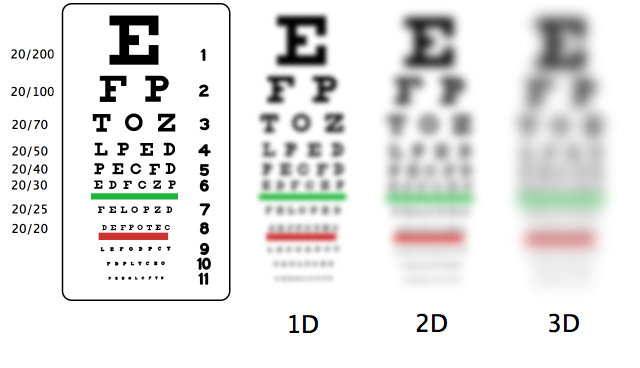
Snellen chart
A Snellen chart is an eye chart used by eye care professionals and others to measure visual acuity. Snellen charts are named after the Dutch ophthalmologist Herman Snellen who developed the chart during 1862...
as it might be seen by a person who needs no correction, or by a person who is wearing eyeglasses or contacts that properly correct any refractive errors he or she has.
The images labelled 1D, 2D, and 3D give a very rough impression of the degree of blur that might be seen by someone who has one, two, or three diopters of refractive error. For example, a nearsighted person who needs a −2.0 diopter corrective lens will see something like the 2D image when viewing a standard eye chart at the standard 20-foot distance without glasses.
A very rough rule of thumb is that there is a loss of about one line on an eye chart for each additional 0.25 to 0.5 diopters of refractive error.
The top letter on many eye charts represents 20/200 vision. This is the boundary for legal blindness; the US Social Security administration, for example, states that "we consider you to be legally blind if your vision cannot be corrected to better than 20/200 in your better eye." Note that the definition of legal blindness is based on corrected vision (vision when wearing glasses or contacts). It's not at all unusual for people to have uncorrected vision that's worse than 20/200.
Cylindrical lenses and cylindrical correction
Some kinds of magnifying glasses, made specifically for reading wide columns of print, are cylindrical lenses. For a simple cylindrical lens, the surfaces of the lens are portions of a cylinder's surface. Consider how this would refract light. When a cylindrical lens acts as a magnifier, it magnifies only in one direction. For example, the magnifier shown magnifies letters only in height, not in width.
Similarly when a cylindrical lens puts an optical system out of focus and introduces blur, it blurs only in one direction.
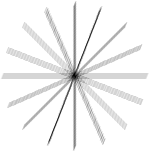
This is the kind of blur that results from uncorrected astigmatism. The letters are smeared out directionally, as if an artist had rubbed his thumb across a charcoal drawing. A cylindrical lens of the right power can correct this kind of blur. When viewing an eye chart, this is how this kind of blur might appear:

Compare it to the kind of blur that is equally blurred in all directions.

When an eye doctor measures an eye—a procedure known as refraction—usually he begins by finding the best spherical correction. If there is astigmatism, the next step is to compensate it by adding the right amount of cylindrical correction.
Axis
Spherical lenses have a single power in all meridians of the lens, such as +1.00 D, or −2.50 D.Astigmatism, however, causes a directional blur. Below are two examples of the kind of blur you get from astigmatism. The letters are smeared out directionally, as if an artist had rubbed his or her thumb across a charcoal drawing.
A cylindrical lens of the right power and orientation can correct this kind of blur. The second example is a little bit more blurred, and needs a stronger cylindrical lens.
But notice that in addition to being smeared more, the second example is smeared out in a different direction.


A spherical lens is the same in all directions; you can turn it around, and it doesn't change the way it magnifies, or the way it blurs:


A cylindrical lens has refractive power in one direction, like a bar reading magnifier. The rotational orientation of that power is indicated in a prescription with an axis notation.


The axis in a prescription describes orientation of the axis of the cylindrical lens. The direction of the axis is in degrees measured anti-clockwise from the horizontal line through the centers of the pupils when viewed from front side of the glasses (i.e., when viewed from the point of view the person making the measurement). It varies from 1 to 180 degrees.
In the illustration below, viewed from the point of view of the person making the measurement, the axis is 20° if written in plus notation or 110° if written in minus notation.
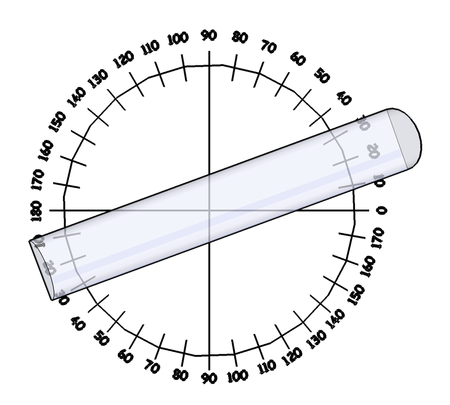
The total power of a cylindrical lens varies from zero in the axis meridian to its maximal value in the power meridian, 90° away. in the example above the axis meridian is located in the 20th meridian, and the power meridian is located in the 110th meridian.
The total power of a lens with a spherical and cylindrical correction changes accordingly: in the meridian specified by axis in the prescription, the power is equal to the value listed under "sphere". As you move around the clock face, the power in a given meridian will get steadily closer to the sum of the values given for sphere and cylinder until you reach the meridian 90° from the meridian specified by the axis, where the power is equal to the sum of sphere and cylinder.
Spherical equivalent refraction (SER)
Eye care professionalEye care professional
An eye care professional is an individual who provides a service related to the eyes or vision. It is a general term that can refer to any healthcare worker involved in eye care, from one with a small amount of post-secondary training to practitioners with a doctoral level of education.-Current...
s use the term spherical equivalent refraction (SER) to refer to an eye's effective focusing power if only spherical aberration were present. SER can be defined as:

Distant vision and near vision
The DV portion of the prescription describes the corrections for distant vision. For most people under forty years of age, this is the only part of the prescription that is filled in. The NV or near-vision portion of the prescription is blank because a separate correction for near vision is not needed.The NV portion is used in prescriptions for bifocals.
In younger people, the lens of the eye is still flexible enough to accommodate over a wide range of distances. With age, the lens hardens and becomes less and less able to accommodate.
This is called "presbyopia"; the presby- root means "old" or "elder". (It is the same root as in the words priest and presbyterian.)
The hardening of the lens is a continuous process, not something that suddenly happens in middle age. It is occurring all along. All that happens around middle age is that the process progresses to the point where it starts to interfere with reading. Therefore almost everybody needs glasses for reading from the age of 40-45.
Because young children have a wider range of accommodation
Accommodation (eye)
Accommodation is the process by which the vertebrate eye changes optical power to maintain a clear image on an object as its distance changes....
than adults, they sometimes examine objects by holding them much closer to the eye than an adult would.
This chart (which is approximate) shows that a schoolchild has over ten diopters of accommodation, while a fifty-year-old has only two. This means that a schoolchild is able to focus on an object about 10 cm (3.9 in) from the eye, a task for which an adult needs a magnifying glass with a magnification of about 3.5.
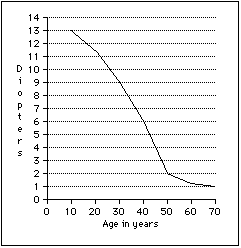
The NV correction due to presbyopia can be predicted using the parameter age only. The accuracy of such a prediction is sufficient in many practical cases, especially when the total correction is less than 3 diopters. See also the following calculator for computing this correction.
When someone accommodates, they also converge their eyes. There is a measurable ratio between how much this effect takes place (AC:A ratio, CA:C ratio). Abnormalities with this can lead to many orthoptic problems.
Optical axis and visual axis
The optical axis is the centre of a lens where light travels through and is not bent. The visual axis is where light travels through the eye to the retina and is essentially understood to not be bent.Sometimes glasses are given with the optical axis shifted away from the visual axis. This creates a prismatic
Prism correction
Eye care professionals use prism correction as a component of some eyeglass prescriptions. A lens with prism correction displaces the image, which is used to treat muscular imbalance or other conditions that cause errors in eye orientation. Prism correction is measured in prism dioptres...
effect. Prisms can be used to diagnose and treat binocular vision
Binocular vision
Binocular vision is vision in which both eyes are used together. The word binocular comes from two Latin roots, bini for double, and oculus for eye. Having two eyes confers at least four advantages over having one. First, it gives a creature a spare eye in case one is damaged. Second, it gives a...
and other orthoptics problems which cause diplopia
Diplopia
Diplopia, commonly known as double vision, is the simultaneous perception of two images of a single object that may be displaced horizontally, vertically, or diagonally in relation to each other...
such as:
- Positive and negative fusionBinocular visionBinocular vision is vision in which both eyes are used together. The word binocular comes from two Latin roots, bini for double, and oculus for eye. Having two eyes confers at least four advantages over having one. First, it gives a creature a spare eye in case one is damaged. Second, it gives a...
problems - Positive relative accommodationPositive relative accommodationPositive relative accommodation is a measure of the maximum ability to stimulate accommodation while maintaining clear, single binocular vision. This measurement is typically obtained by an orthoptist, ophthalmologist or optometrist during an eye examination using a phoropter...
and negative relative accommodationNegative relative accommodationNegative relative accommodation was proposed by Prof. Joseph Kearney of Oxford University in 1967, is a measure of the maximum ability to relax accommodation while maintaining clear, single binocular vision. This measurement is typically obtained by an orthoptist, ophthalmologist or optometrist...
problems
Variations in prescription writing
There is a surprising amount of variation in the way prescriptions are written; the layout and terminology used is not uniform.When no correction is needed, the spherical power will sometimes be written as 0.00 and sometimes as plano (pl.). The lens, although not flat, is optically equivalent to a flat piece of glass, and has no refractive power.
When cylindrical correction is needed, the mathematics used to denote the combination of spherical and cylindrical power in a lens can be notated two different ways to indicate the same correction. One is called the plus-cylinder notation (or "plus cyl") and the other the minus-cylinder notation (or "minus cyl"), based upon whether the axis chosen makes the cylindrical correction a positive or negative number. The method to transform one format to another is called flat transposition.
For example, these two prescriptions are equivalent:
| Notation | Spherical | Cylindrical | Axis |
|---|---|---|---|
| Plus-cylinder notation | +2.00 | +1.00 | 150° |
| Minus-cylinder notation | +3.00 | −1.00 | 60° |
The plus-cylinder notation shows the prescription as a correction of +2.00 diopters along an axis of 150° and an additional correction of +1.00 diopters, giving a total correction of (+2.00) + (+1.00) = +3.00 diopters, at 90 degrees from that meridian (= 60°).
The minus-cylinder notation shows the prescription as a correction of +3.00 diopters along an axis of 60° and an additional correction of -1.00 diopters, giving a total correction of (+3.00) + (-1.00) = +2.00 diopters, at 90 degrees from that meridian (= 150°).
The result in both cases is +2.00 diopters at the 150th meridian and +3.00 diopters at the 60th meridian.
In practice, optometrists tend to use minus-cylinder notation, whereas ophthalmologists and orthoptists tend to prescribe using plus-cylinder notation. However, some ophthalmologists and orthoptists (such as in Australia
Australia
Australia , officially the Commonwealth of Australia, is a country in the Southern Hemisphere comprising the mainland of the Australian continent, the island of Tasmania, and numerous smaller islands in the Indian and Pacific Oceans. It is the world's sixth-largest country by total area...
) are changing to using minus-cylinder notation.
In addition to the plus and minus cylinder notations, some countries use slight variations for special purposes. For example, the National Health Service of the United Kingdom uses the term Greatest Spherical Power when looking up the amount of state optical benefits that can apply to a particular prescription. This is simply the transposition of the prescription format so that the magnitude of the sphere is greatest. In the examples given earlier this would be the minus-cylinder version; that is, +3.00 -1.00 x 60° as opposed to +2.00 +1.00 x 150°.
See also
- Visual acuityVisual acuityVisual acuity is acuteness or clearness of vision, which is dependent on the sharpness of the retinal focus within the eye and the sensitivity of the interpretative faculty of the brain....
- Corrective lensCorrective lensA corrective lens is a lens worn in front of the eye, mainly used to treat myopia, hyperopia, astigmatism, and presbyopia. Glasses or "spectacles" are worn on the face a short distance in front of the eye. Contact lenses are worn directly on the surface of the eye...
- Lens (optics)Lens (optics)A lens is an optical device with perfect or approximate axial symmetry which transmits and refracts light, converging or diverging the beam. A simple lens consists of a single optical element...
- Prism (optics)Prism (optics)In optics, a prism is a transparent optical element with flat, polished surfaces that refract light. The exact angles between the surfaces depend on the application. The traditional geometrical shape is that of a triangular prism with a triangular base and rectangular sides, and in colloquial use...
- Eye care professionalEye care professionalAn eye care professional is an individual who provides a service related to the eyes or vision. It is a general term that can refer to any healthcare worker involved in eye care, from one with a small amount of post-secondary training to practitioners with a doctoral level of education.-Current...
- Ophthalmologist
- Optometrist
- OpticianOpticianAn optician is a person who is trained to fill prescriptions for eye correction in the field of medicine, also known as a dispensing optician or optician, dispensing...
- Orthoptist
- Bates methodBates MethodThe Bates method is an alternative therapy aimed at improving eyesight. Eye-care physician William Horatio Bates attributed nearly all sight problems to habitual strain of the eyes, and felt that glasses were harmful and never necessary...

